
FACULTY OF COMMUNICATION
Department of Public Relations and Advertising
PRA 486 | Course Introduction and Application Information
| Course Name |
Communication Agency II
|
|
Code
|
Semester
|
Theory
(hour/week) |
Application/Lab
(hour/week) |
Local Credits
|
ECTS
|
|
PRA 486
|
Fall/Spring
|
0
|
12
|
6
|
9
|
| Prerequisites |
|
|||||||||||||||||
| Course Language |
English
|
|||||||||||||||||
| Course Type |
Elective
|
|||||||||||||||||
| Course Level |
First Cycle
|
|||||||||||||||||
| Mode of Delivery | face to face | |||||||||||||||||
| Teaching Methods and Techniques of the Course | DiscussionGroup WorkProblem SolvingCase StudyQ&ACritical feedbackSimulationApplication: Experiment / Laboratory / Workshop | |||||||||||||||||
| Course Coordinator | ||||||||||||||||||
| Course Lecturer(s) | ||||||||||||||||||
| Assistant(s) | - | |||||||||||||||||
| Course Objectives | To provide PRA and VCD graduates who can experience agency environment at on-site, real-time simulation agency within the university. |
| Learning Outcomes |
The students who succeeded in this course;
|
| Course Description | Public relations and advertising students during their last year of study will actually work on the front line (going through stages in real-life) in an actual advertising agency setting. This applies without exception to all conditions in an agency such as real-time placement, operation and management: - Job application and interview are followed by identification of job descriptions and responsibilities of preferred position / department. Afterwards, students are provided with an orientation to familiarize them with the agency’s internal processes. Students are expected to develop an understanding of both agency’s internal process and the use of forms - Things to do from the first day of co-operation with the agency’s client (acquaintance, general briefing, meeting with account group, taking brief from client, deepening information, development and finalization of work schedule) - Development and finalization of communication strategy with inner workings of account group and evaluation of the strategy by agency management, preparation for the presentation - Strategy presentation for the client. Receiving comments and suggestions; making necessary corrections and modifications - Group doing creative work in line with the approved strategy and production of necessary communication materials (ads, movies, posters, radio, outdoor advertising, printed and digital materials, PR suggestions, marketing events, etc.), writing and graphic design works prepared as draft first and presenting them to client only after the approval of agency management - Developing media strategy for the proposed marketing communication campaign and making media planning decisions after the approval. - During the whole process, maintaining the required relationships via communication methods such as interviews, e-mail, telephone and SMS and preparing reports accordingly - Conducting interviews in which the performance is evaluated on a regular basis: each employee is provided with an performance evaluation form and receives info, which acts as an important step in his/her career planning - With the support of agency management, developing and finalizing Individual professional portfolio which will occur gradually At the end of the year an event in which the agency’s works are exhibited is planned in order to provide an opportunity for students to meet with representatives from the leading agencies of advertising industry. |
|
|
Core Courses | |
| Major Area Courses |
X
|
|
| Supportive Courses | ||
| Media and Management Skills Courses | ||
| Transferable Skill Courses |
WEEKLY SUBJECTS AND RELATED PREPARATION STUDIES
| Week | Subjects | Related Preparation |
| 1 | Evaluation of the previous term and planning the projects for the semester | |
| 2 | Systems for thinking and developing an advertising idea | Rossiter, J.; Langner, T.; Ang, L. (2003): “Visual creativity in advertising: a functional tipology”. ANZMAC 2003 Conference Proceedings. Adelaide 1-3 December 2003, 105-113. Kilgour, M., & Koslow, S. (2009). Why and how do creative thinking techniques work?: Trading off originality and appropriateness to make more creative advertising. Journal of the Academy of Marketing Science, 37(3), 298-309. |
| 3 | Systems for thinking and developing an advertising idea | Koslow, S., Sasser, S. L., & Riordan, E. A. (2006). Do marketers get the advertising they need or the advertising they deserve? Agency views of how clients influence creativity. Journal of Advertising, 35(3), 81-101. |
| 4 | Functions and processes of "New Business" | |
| 5 | Meeting with clients and receiving briefs | |
| 6 | Working on briefs | Arden, P. (2006). Whatever you think think the opposite. London: Penguin. Pp. 1-47. |
| 7 | Working on briefs | Arden, P. (2006). Whatever you think think the opposite. London: Penguin. pp. 48-101. |
| 8 | Working on briefs | Arden, P. (2006). Whatever you think think the opposite. London: Penguin. pp.103-140. |
| 9 | Presentations to clients | Johar, G. V., Holbrook, M. B., & Stern, B. B. (2001). The role of myth in creative advertising design: Theory, process and outcome. Journal of Advertising, 30(2), 1-25. |
| 10 | Presentations to clients | |
| 11 | Presentations to clients | |
| 12 | Works for portfolio | |
| 13 | Performance evaluation | |
| 14 | Final exhibition | |
| 15 | Semester Review | |
| 16 | Semester Review |
| Course Notes/Textbooks |
|
|
| Suggested Readings/Materials |
|
EVALUATION SYSTEM
| Semester Activities | Number | Weigthing |
| Participation |
1
|
10
|
| Laboratory / Application |
1
|
50
|
| Field Work | ||
| Quizzes / Studio Critiques | ||
| Portfolio | ||
| Homework / Assignments |
1
|
10
|
| Presentation / Jury | ||
| Project |
1
|
30
|
| Seminar / Workshop | ||
| Oral Exams | ||
| Midterm | ||
| Final Exam | ||
| Total |
| Weighting of Semester Activities on the Final Grade |
5
|
100
|
| Weighting of End-of-Semester Activities on the Final Grade | ||
| Total |
ECTS / WORKLOAD TABLE
| Semester Activities | Number | Duration (Hours) | Workload |
|---|---|---|---|
| Theoretical Course Hours (Including exam week: 16 x total hours) |
16
|
0
|
|
| Laboratory / Application Hours (Including exam week: '.16.' x total hours) |
16
|
12
|
192
|
| Study Hours Out of Class |
9
|
2
|
18
|
| Field Work |
0
|
||
| Quizzes / Studio Critiques |
0
|
||
| Portfolio |
0
|
||
| Homework / Assignments |
1
|
10
|
10
|
| Presentation / Jury |
0
|
||
| Project |
1
|
50
|
50
|
| Seminar / Workshop |
0
|
||
| Oral Exam |
0
|
||
| Midterms |
0
|
||
| Final Exam |
0
|
||
| Total |
270
|
COURSE LEARNING OUTCOMES AND PROGRAM QUALIFICATIONS RELATIONSHIP
|
#
|
Program Competencies/Outcomes |
* Contribution Level
|
||||
|
1
|
2
|
3
|
4
|
5
|
||
| 1 | To be able to critically interpret theories, concepts, methods, instruments and ideas that form the basis of Public Relations and Advertising field. |
X | ||||
| 2 | To be able to collect and use necessary data to produce content in the field of Public Relations and Advertising with scientific methods. |
|||||
| 3 | To be able to use theoretical knowledge gained in the field of Public Relations and Advertising in practice. |
X | ||||
| 4 | To be able to use analytical thinking skills in the field of Public Relations and Advertising. |
X | ||||
| 5 | To be able to convey creative ideas and solution suggestions supported by scientific data in written and oral form to stakeholders. |
X | ||||
| 6 | To be able to take responsibility as individual and group members to solve problems encountered in the practice of Public Relations and Advertising field. |
X | ||||
| 7 | To be able to develop solutions that favor public good and raise awareness by having knowledge about regional, national and global issues and problems. |
X | ||||
| 8 | To be able to relate the basic knowledge of other disciplines supporting the field of Public Relations and Advertising with his/her own field of expertise. |
|||||
| 9 | To be able to use the knowledge, skills and competencies acquired by following regulations, innovations, changes, current developments, and occupational health and safety practices closely in the field of Public Relations and Advertising; in a lifelong manner and for individual and social purposes. |
|||||
| 10 | To be able to collect, interpret and share data by considering social, scientific and professional ethical values in the field of Public Relations and Advertising. |
|||||
| 11 | To be able to collect data in the areas of Public Relations and Advertising and communicate with colleagues in a foreign language ("European Language Portfolio Global Scale", Level B1) |
|||||
| 12 | To be able to speak a second foreign at a medium level of fluency efficiently. |
|||||
| 13 | To be able to relate the knowledge accumulated throughout the human history to their field of expertise. |
|||||
*1 Lowest, 2 Low, 3 Average, 4 High, 5 Highest
NEWS |ALL NEWS
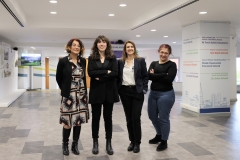
1.3 million support from TUBITAK for the exemplary project
4 academics from Izmir University of Economics (IUE) took action on the increase in natural disasters such as floods, fires, tornadoes and
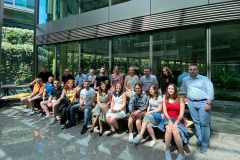
7 industrial visits in 3 days
Izmir University of Economics (IUE) Department of Public Relations and Advertising organized an industrial visit to Istanbul for its students to offer
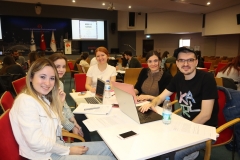
‘Kindness in Communication’ ideas by IUE students
Students of Department of Public Relations and Advertising, Izmir University of Economics (IUE) developed creative ideas for a world-famous tire brand (Continental)

‘Kindness in Communication’ ideas by IUE students
Students of Department of Public Relations and Advertising, Izmir University of Economics (IUE) developed creative ideas for a world-famous tire brand (Continental)
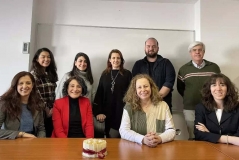
Our department, which was accredited by the Communication Research Association (ILAD) in 2020, successfully completed the interim evaluation process and was entitled to a total of five years of accreditation.
ILAD, the national quality assurance institution authorized by the Higher Education Quality Board (YÖKAK) for communication education, accredited our Public Relations and
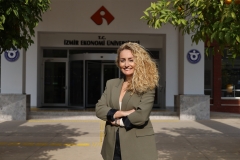
IUE graduate academic at a world-renowned university
Lena Çavuşoğlu, a graduate of Izmir University of Economics (IUE), pursued her dreams about having an academic career abroad instead of working

'International' cooperation of Izmir University of Economics
Izmir University of Economics (IUE) Department of Public Relations and Advertising took another important step towards internationalization and collaborated with the famous

